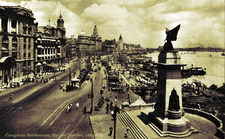Cangshan
| Cangshan | |||
| |||
| Nickname: | The Treaty Port | ||
| Map: | 
|
||
| Abbreviation | |||
| Province | Zhongji | ||
| District | Jiyuan | ||
| Founded | Unknown | ||
| Demonym | |||
| Mayor | Han Kow | ||
| Boroughs | |||
| Populations | 118,638 (1684 AN) | ||
Treaty port of Cangshan was a Jingdaoese city, located in the Zhongji Province. For a long time, it was a small fishing village at the crossroads between the larger cities of Gangdiguo and Nangnang. Because of its proximity to some of the better infrastructure within the Empire, in 1672 AN, it was chosen as one of the two Treaty Ports (along with Jasoniacheng). The town grew in a full-fledged, modern city between 1672 and 1681 AN.
Growth into a city
The town saw an influx of Aldurian families and enterprising Jingdaoese who each established their own communities. The town, while heavily monitored to avoid the spread of impure political ideas, saw the construction of buildings based on Aldurian architecture. It also became one of the famous tourist spots of the wealthier elite, who were curious of the way foreigners lived. Large parts of the town saw the construction of luxurious mansions with extensive gardens, both in Jingdaoese and Aldurian style.
With wealth pouring in, the harbour facilities were rapidly expanded. Churches and bath houses were built to accommodate the Aldurian community, as they were officially tolerated by the Heavenly Light. Some parallels were made between the status of the Aldurians and the Bassarids in the past (they were also forbidden to settle and preach until and economic agreement improved the cooperation). Hope for a common, prosperous future was not uncommon among the population of Cangshan.
Demise of wealth
After nine years, the situation changed drastically. With Alduria having joined the Raspur Pact, the lives of the residents became heavily restricted. According to official sources, the authorities could not risk any extra manpower to safeguard foreigners outside of their communities. In reality, both the police services as Tegong became very reluctant to aid a potential enemy power. Those who once had worked well together, stopped talking. Any community projects which brought together Aldurian and Jing children were abruptly ended due to a lack of funding. Mixed marriages, while always looked down upon by both sides, were now scorned and sometimes the couple was even forced to divorce.
Unrest and violence against those of non-Jing descent increased ever since. Especially since the 1684's, when the 1684 Jingdaoese-Alriggian border incidents led to a heightened anti-foreigner rhetoric. The establishment of a joint task force to keep the peace led to increased tension, as several of the policemen were charged with using unnecessary violence against Jingdaoese protesters.
Trade, while formally not halted, diminished throughout the years, as custom officers were increasingly harsh on expecting imported goods. Introduction of indirect taxes (even dubbed illegal by some higher officials, but mostly ignored by the Grand Secretariat) and racism towards the merchants made it difficult for Aldurian residents to earn their wage.
While unofficial, the town acts as largest smuggling ring to import and export goods between the USSO and Raspur.
